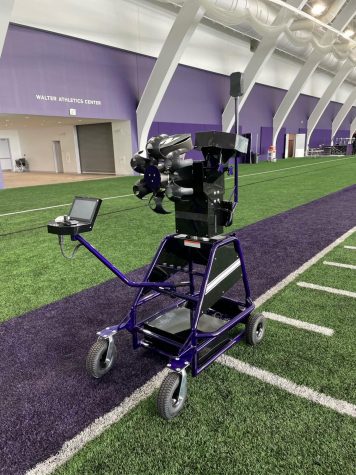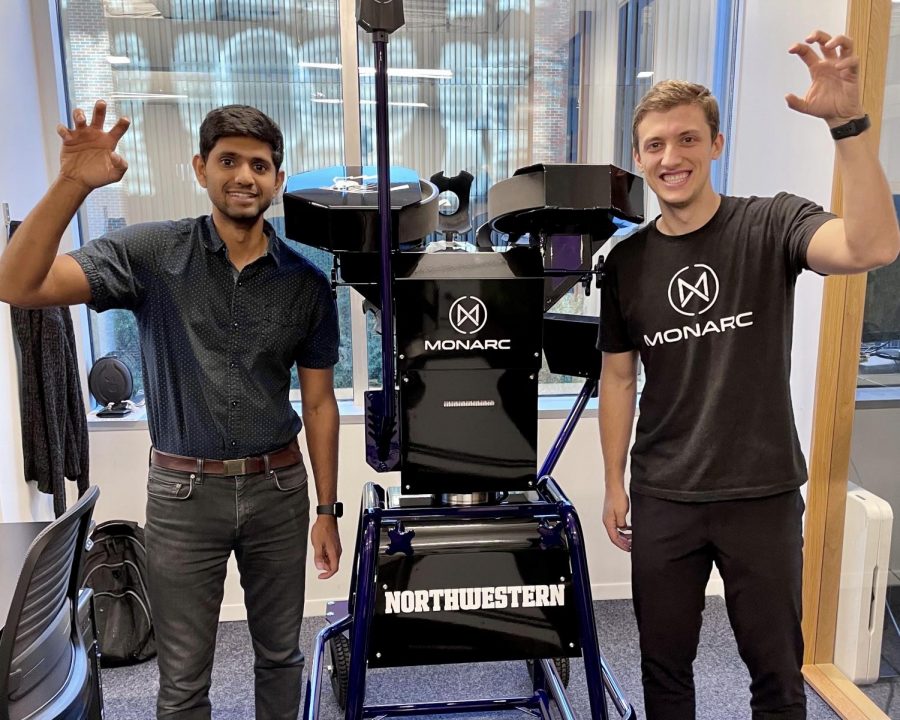No quarterback? No problem. NU alumni design world’s first robotic quarterback
Bhargav Maganti (left) and Igor Karlicic with Northwestern’s customized Seeker. The Seeker is the world’s first robotic quarterback, and it uses tracking technology to make passes more accurate and practices more efficient.
February 18, 2021
Football
A new quarterback made its way into Ryan Fieldhouse on Friday — and no, it wasn’t Ryan Hilinski.
A 6-foot tall, purple and black robot called the Seeker, designed by Northwestern alumni Bhargav Maganti (McCormick ’12) and Igor Karlicic (McCormick ’12), gives the Wildcats’ pass catchers an accurate and efficient tool to throw the ball without a quarterback.
The Seeker’s third co-founder, Iowa graduate Nate Pierotti, roomed with a walk-on receiver in college who was frustrated by his lack of practice reps, and wanted to get better on his own. Pierotti played wide receiver in high school, and had used the JUGS Football Machine, a popular pass throwing tool. But he’d struggled to set it up on his own, and wanted to create something more accurate, and easier to use.
With only a blueprint for the Seeker on hand, Pierotti pitched it in 2016 to Iowa Assistant Director of Football Operations Ben Hansen. Hansen, excited by the idea, assisted the Seeker team on the football end of the project, and allowed the team to use their facilities.
“The JUGS machine hasn’t been updated in a long time,” Hansen said. “At that time, I was like, ‘this sounds awesome.’”
In the early stages of the Seeker’s development, Hansen said the team was inside the Iowa facility whenever they were allowed. The old model traveled on big wheels, and had traditional wall plugs, a far cry from the current iteration. Maganti, Karlicic, Pierotti and their team would fire one football, and track all of the data — where the ball went, how fast it traveled, how accurate their throw was — which they used to refine their algorithm.
The Seeker can fire up to six footballs at a time, and comes with two modes, robotic and manual. The manual mode allows players to select with a touchscreen where the ball will go, and customize its location and what type of play it will simulate: a pass, punt or kick.
Mechanical engineers Karlicic and Maganti were drawn to the project because of the tracking technology behind robotic mode. With robotic mode, the Seeker tracks the user’s location, and can interact with them based on that data. The receiver wears a small device which tracks their speed, location and acceleration. It can even anticipate their route, firing a ball on that route.

Maganti and Karlicic, who were roommates at Northwestern, began working on the Seeker as a side project.
“We weren’t originally football superfans, or anything,” Maganti said. “It was just something that was intellectually stimulating. The athletic piece of it, and that engagement and emotional connection to our audience, is something that caught up with us later.”
Developing the project at Iowa gave Karlicic and Maganti the opportunity to frequently test out and tweak the Seeker with the Hawkeyes’ players and staff. The player feedback at Iowa led to the Seeker team focusing on randomizing throws and simulating a game-type environment, with bad throws or tipped passes. Hansen said the players found new functionalities, like using the machine for defensive back drills.
Iowa was one of the Seeker’s earliest supporters, but the machine is now in use at six NCAA universities: Northwestern, SMU, Oklahoma, Virginia and LSU.
During the pandemic, the Seeker picked up steam in NFL circles. With receivers at home, and no quarterback to throw passes, Monarc saw an opportunity to pivot their target audience and connect with NFL receivers.
“We started engaging with these athletes that were at home, and it organically spread,” Karlicic said. “We initially started working with (Detroit Lions receiver) Danny Amendola in Austin. He made a few videos that other athletes started to spread.”
Now, Monarc’s list of over 25 NFL customers includes big names like San Francisco 49ers tight end George Kittle, Pittsburgh Steelers tight end Eric Ebron and Lions tight end T.J. Hockenson.
While Maganti and Karlicic weren’t football superfans before they started developing the Seeker, the two have fond memories of Northwestern football. Karlicic said delivering Northwestern’s new machine was a full-circle moment.
“We’re really excited to be delivering Northwestern’s,” Karlicic said. “That’s where our journey started. Creating things in Ford, and learning how to think like engineers. To circle back all these years later and engage with the University in a really meaningful way, we’re super stoked.”
Email: [email protected]
Twitter: @gablcarroll
Related Stories:
— Football: Quarterback Ryan Hilinski transfers to Northwestern from University of South Carolina
— Football: Northwestern quarterback Peyton Ramsey shines in Citrus Bowl, earns MVP honors
— Football: After five years in Evanston, Ramaud Chiaokhiao-Bowman’s moment has finally arrived


